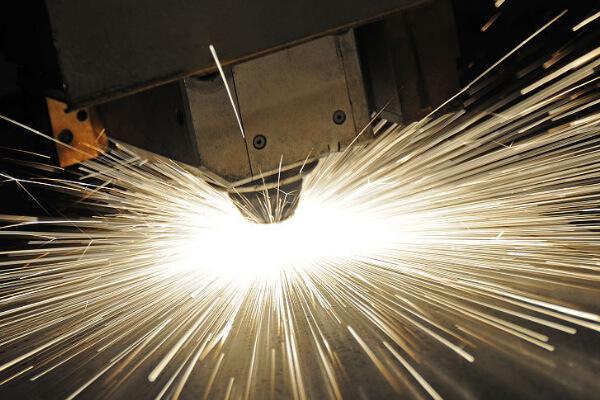The principle of laser cutting machine
The principle of laser cutting machine
Laser cutting is to make the irradiated material melt, vaporize, ablate or reach the ignition point by irradiating the workpiece with the focused high power density laser beam, and at the same time remove the molten material by means of the high-speed airstream coaxial with the light beam, so as to realize the cutting of the workpiece. Laser cutting is one of the thermal cutting methods. The principle of laser cutting is shown below.
Types of laser cutting
Laser vaporization cutting is mainly used for cutting extremely thin metal materials and non-metal materials (such as paper, cloth, wood, plastics and rubber, etc.).
1. Fusion cutting
During laser fusion and cutting, metal materials are melted by means of laser heating, and non-oxidizing gases (Ar, He, N, etc.) are sprayed by the nozzle. Liquid metal is discharged by the strong pressure of the gas to form an incision. It only takes a tenth of the energy to vaporize the cut.
Laser fusion cutting is mainly used for cutting non-oxidizable materials or active metals, such as stainless steel, titanium, aluminum and their alloys.
2. Vaporization cutting
Heat the workpiece with a high energy density laser beam. Vaporize in a short time to form steam. An incision is made in the material. The heat of vaporization of the material is usually very large, so the laser vaporization cutting needs high power and power density.
3. Scribing and controlling fracture
Laser scribing is to use high-energy density laser scanning on the surface of brittle materials, so that the material is heated to evaporate out of a small groove, and then apply a certain pressure, brittle materials will be split along the small groove. Generally, the laser used for laser scribing is Q switching laser and CO2 laser cutting.
Controlling fracture is to make use of the steep temperature distribution generated during laser cutting, to generate local thermal stress in brittle materials and to break the material along the small groove.
4. Oxygen cutting
It USES laser as preheating heat source and oxygen as cutting gas. On the one hand, the gas blown out ACTS with cutting metal and produces oxidation reaction, giving off a lot of heat of oxidation. On the other hand, molten oxides and melts are blown out of the reaction zone, and the cutting speed is much faster than laser vaporization cutting and fusion cutting.
Laser oxygen cutting is mainly used in carbon steel, titanium steel, heat treated steel and other easily oxidized metal materials.
Application range of laser cutting
Most laser cutting machines are controlled by a numerical control program or made into cutting robots. As a precision machining method, laser cutting can cut almost all materials, including the two-dimensional or three-dimensional cutting of thin metal plates.
Laser cutting system is also widely used in the field of non-metallic materials. Such as silicon nitride, ceramics, quartz, etc. Flexible material, such as cloth, paper, plastic board, rubber, etc.
Laser cutting is to make the irradiated material melt, vaporize, ablate or reach the ignition point by irradiating the workpiece with the focused high power density laser beam, and at the same time remove the molten material by means of the high-speed airstream coaxial with the light beam, so as to realize the cutting of the workpiece. Laser cutting is one of the thermal cutting methods. The principle of laser cutting is shown below.
Laser vaporization cutting is mainly used for cutting extremely thin metal materials and non-metal materials (such as paper, cloth, wood, plastics and rubber, etc.).
1. Fusion cutting
During laser fusion and cutting, metal materials are melted by means of laser heating, and non-oxidizing gases (Ar, He, N, etc.) are sprayed by the nozzle. Liquid metal is discharged by the strong pressure of the gas to form an incision. It only takes a tenth of the energy to vaporize the cut.
Laser fusion cutting is mainly used for cutting non-oxidizable materials or active metals, such as stainless steel, titanium, aluminum and their alloys.
2. Vaporization cutting
Heat the workpiece with a high energy density laser beam. Vaporize in a short time to form steam. An incision is made in the material. The heat of vaporization of the material is usually very large, so the laser vaporization cutting needs high power and power density.
3. Scribing and controlling fracture
Laser scribing is to use high-energy density laser scanning on the surface of brittle materials, so that the material is heated to evaporate out of a small groove, and then apply a certain pressure, brittle materials will be split along the small groove. Generally, the laser used for laser scribing is Q switching laser and CO2 laser cutting.
Controlling fracture is to make use of the steep temperature distribution generated during laser cutting, to generate local thermal stress in brittle materials and to break the material along the small groove.
4. Oxygen cutting
It USES laser as preheating heat source and oxygen as cutting gas. On the one hand, the gas blown out ACTS with cutting metal and produces oxidation reaction, giving off a lot of heat of oxidation. On the other hand, molten oxides and melts are blown out of the reaction zone, and the cutting speed is much faster than laser vaporization cutting and fusion cutting.
Laser oxygen cutting is mainly used in carbon steel, titanium steel, heat treated steel and other easily oxidized metal materials.
Application range of laser cutting
Most laser cutting machines are controlled by a numerical control program or made into cutting robots. As a precision machining method, laser cutting can cut almost all materials, including the two-dimensional or three-dimensional cutting of thin metal plates.
Laser cutting system is also widely used in the field of non-metallic materials. Such as silicon nitride, ceramics, quartz, etc. Flexible material, such as cloth, paper, plastic board, rubber, etc.



评论
发表评论